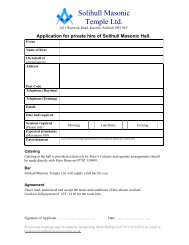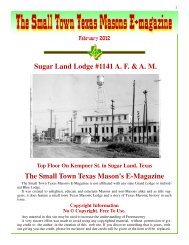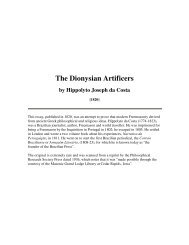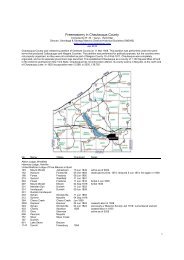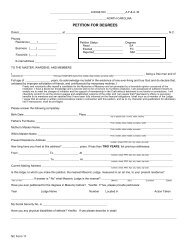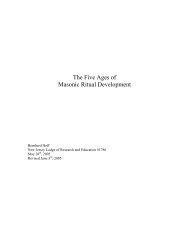Entered apprentice info - MasterMason.com
Entered apprentice info - MasterMason.com
Entered apprentice info - MasterMason.com
You also want an ePaper? Increase the reach of your titles
YUMPU automatically turns print PDFs into web optimized ePapers that Google loves.
which they stand had not even been invented. All the more necessary, then, that the foundation<br />
on which all the work was done should be as perfect as the Masters knew how to make it.<br />
Cathedral builders erected their temples for all time - how well they built, a hundred glorious<br />
structures in the Old World testify. They built well because they knew how to check and try their<br />
squares!<br />
Today any school boy knows the simple "secret of the square" which was then the closely<br />
guarded wisdom of the Masters alone; toady any school boy can explain the steam engine which<br />
was a wonder two hundred years ago, and make and use a wireless which was a miracle scarce<br />
ten years gone by. Let us not wonder that our ancient Operative brethren thought their secret of a<br />
square so valuable; let us rather wonder that in time in which the vast majority of men were<br />
ignorant of mathematics, so many must have known and appreciated this simple, this marvelous,<br />
geometrical secret.<br />
Lay out a circle - any size - on a piece of paper. With a straight edge draw a line across through its<br />
center. Put a dot on the circle, anywhere. Connect that dot with the line at both points where it<br />
crosses the circle. Results - a perfect right triangle.<br />
Draw the circle of whatever size you will; place a dot on the circumference where you will, it<br />
makes no difference. So be it. So be it the lines from the dot meet the horizontal line crossing the<br />
circle through its center and they will form a right angle.<br />
This was the Operative Mason's secret - knowing how "to try his square." It was by this means<br />
that he tested the working tools of the Fellows of the Craft; he did so often enough, and it was<br />
impossible either for their tools or their work "to materially err." From this, also, <strong>com</strong>es the ritual<br />
used in the lodges of our English brethren, where they "open on the center." Alas, we have<br />
dropped the quaint old words they use, and American Lodges know the "center" only as the point<br />
within a circle. The original line across the center has been shifted to the side and became the<br />
"two perpendicular parallel lines" of Egypt and India and our admonitions are no longer what they<br />
must have once been; . . . "while a mason circumscribes his "square" within these points, it is<br />
impossible that "it" should materially err."<br />
Today we only have our Speculative meaning; we circumscribe our desires and our passions<br />
within the circle and the lines touching on the Holy Scriptures. For Speculative Masons who use<br />
squares only in the symbolic sense such an admonition is of far greater use than would be the<br />
secret of the square as was known to our ancient brethren.<br />
But - how much greater be<strong>com</strong>es the meaning of the symbol when we see it as a direct descent<br />
from an Operative practice! Our ancient brethren used the point within a circle as a test for the<br />
rectitude of the tools by which they squared their work and built their temporal buildings. In the<br />
Speculative sense, we used it as a test for the rectitude of our intentions and our conduct, by<br />
which we square our actions with the square of virtue. They erected<br />
Cathedrals - we build the "House Not Made With Hands." Their point within a circle was Operative<br />
- ours is Speculative!<br />
But through the two - point in a circle on the ground by which an Operative Master secretly tested<br />
the square of his fellows - point within a circle as a symbol by which each of us may test,<br />
secretly, the square of his virtue by which he erects an Inner Temple to the Most High - both are<br />
Masonic, both are beautiful. The one we know is far more lovely that it is a direct descendant of<br />
an Operative practice the use of which produced the good work, true work, square work of the<br />
Master Masons of the days that <strong>com</strong>e not back.<br />
Pass it not lightly. Regard it with the reverence it deserves, for surely it is one of the greatest<br />
teachings of Masonry, concealed within a symbol which is plain for any man to read, so be it he<br />
has Masonry in his heart.<br />
7



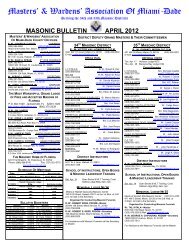
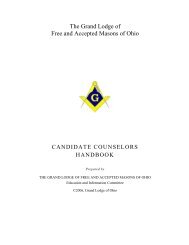
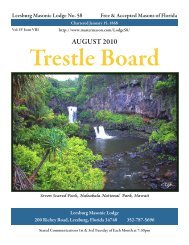

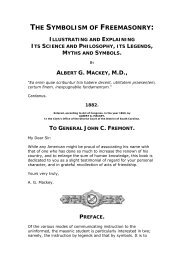

![Junior Grand Warden Views [2005-2] - MasterMason.com](https://img.yumpu.com/36303049/1/190x245/junior-grand-warden-views-2005-2-mastermasoncom.jpg?quality=85)
